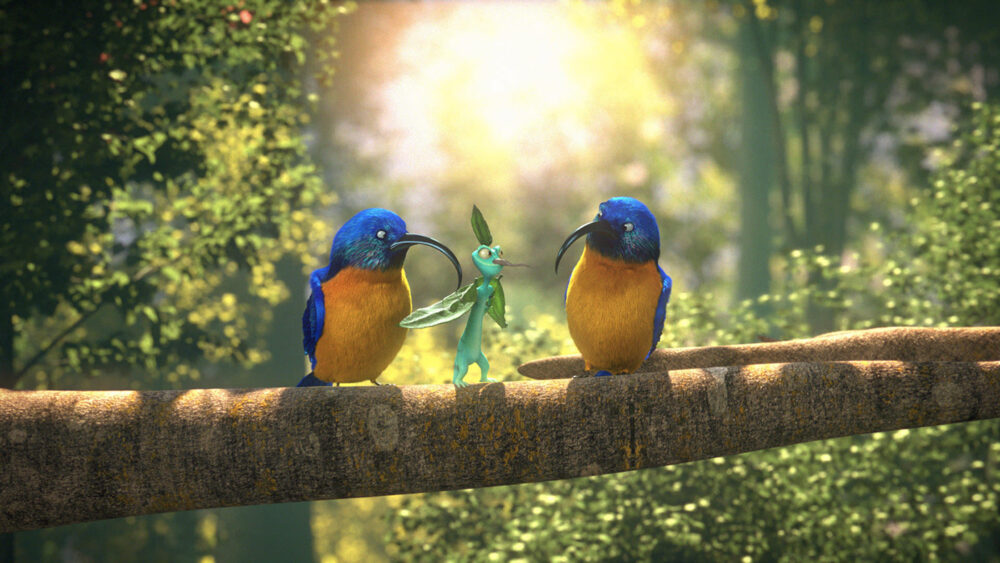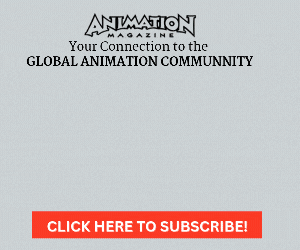|
Getting your Trinity Audio player ready...
|
A chameleon learns to live by his own rules and be true to his own colors in writer-director’s Alex Ross’s charming new short The Social Chameleon. We had the chance to ask the first-time filmmaker a few questions in a recent e-mail interview:
Animation Magazine: Can you tell us a bit about the origins and genesis of your short?

Alex Ross: I’ve always been pretty adept at blending in, but I never really felt like I belonged anywhere. Nobody ever called me a “social chameleon” (to my face at least), but the saying always struck a chord with me. I think because it has such a negative connotation, I wanted to flip the expression on its head and give it an alternative interpretation. The story follows a chameleon named Cosmo who tries to blend in with the other animals, because he doesn’t know how to be himself. He doesn’t change colors, or even know that he can, until he meets another chameleon who shows him what it means to live by his own colors.
It’s a story I struggled to complete for some time. I knew the beginning and middle, but hadn’t figured out the end. Despite wanting to be an artist, I didn’t know how to be one. All the creatives I knew and admired were so confident and comfortable in their own skins; something I was not. I hadn’t figured out who I was, so I had little hope for my chameleon.
Fortunately, a good friend, a bit of psilocybin and a chameleon episode of Planet Earth allowed me to revisit the story with a new perspective. It might sound obvious or cliché, but I realized that art is putting vulnerability on display. The vulnerability I was feeling was not only good, but it was the secret sauce. The pain, the fear, the shame — all of it ended up being what allowed my story to connect with a much more universal audience than I expected.
It was a pretty beautiful first film to start my writing and directing career. It’s definitely informed my approach to story, and I’ve never felt more confidently myself.
What are some of your animation inspirations?
I grew up on a lot of Tex Avery and Chuck Jones. My dad wasn’t the biggest fan of modern cartoons when I was growing up, so my Saturday morning cartoons ended up being Golden Age Looney Tunes, Tom & Jerry and other classics. I also grew up on the rise of the Pixar short. I loved those short but sweet, heartfelt films at the beginning of the Pixar movies. With this film, I aimed to combine the shiny, polished look and heart of Pixar, with the score-driven, pantomime fun and games of older cartoons.
When did you start working on the short and how long did it take to make?
I drew the original (very crude) storyboard on index cards and did some preliminary character sketches in 2018. It wasn’t great, but it was enough to get the story across. It wasn’t until my producer, Andrew Austin, started bringing on our extraordinarily talented team of seasoned veterans that it really started to hum to life. After pre-production, we had some trouble finding the right studio to produce the 3D animation, but fortunately met an extremely devoted and passionate match with Citrus Ink Studios.
What was your ballpark budget?
More money than I would have liked, and much less than it should have cost.
How many people worked on it with you?
About 120 people from around the world. We did all our creative development, pre-production and post with Paper Anvil in Los Angeles, our 3D animation in New Delhi, India with Citrus Ink Studios, our orchestration in Budapest, Hungary with the Budapest Art Orchestra, and our very lovely and talented editor Romana Cicova was based in the U.K.
Which animation tools did you use?
Pre-production: Storyboard Pro and Harmony. Production: Primarily Maya for the 3D animation, but the 2D animation was done in Harmony. Also big shout out to Frame.io for making the time zones much more manageable for notes / draw-overs.
Why did you decide to go the dialog-free route?
Letting the music and sound design drive the acting and emotion was always my plan. I wanted the full soundscape of classic cartoons, and the heart of a Pixar short. It’s a story that lends itself to showing instead of telling.
Looking back, what would you say were your biggest challenges?
Finding the right studio was an enormous challenge. Originally, we had a studio that promised us the world, and then completely disappeared on us. I was pretty disheartened, to say the least. Fortunately, Andrew introduced me to Vrinda Sood over at Citrus Ink Studios, and we were not only able to move forward, but they truly poured their hearts and souls into the film.
Beyond that, the music was definitely a big challenge to get right. Fortunately, our extremely talented composer, Logan Stahley, knocked it out of the park. It took us a bit to find the right tone, but after I asked him to binge Tom & Jerry he came back with a perfect fit.
We had many road bumps along the way, but I’m incredibly grateful to have had such an amazing team behind me throughout the entirety of the project. Everyone really believed in it and gave it their all.
Which aspect of the short are you happiest with?
There’s no single piece that I’m more proud of than the rest, and this film wouldn’t exist without many of the people I’ve already mentioned. However, I think this story works because of the acting, and that specific and very large part of it is owed to Larry Scholl. Larry is an incredibly talented storyboard artist who is able to imbue such compelling emotion into his drawings. He laid the foundation of the acting in our reel and boards, and Andrew helped me to realize it in actual production.
Overall, I’m just thrilled with how well it’s been received around the world. We’ve played in 55 festivals around the world, won eight awards, and I’ve met so many wonderful new friends and colleagues.
What’s the best advice you can give newbie short filmmakers?
Don’t stop. It’s going to be hard, it’s going to take longer than you want, you’re going to doubt yourself, but if you keep pushing you’ll get to the finish line.
What are you working on next?
I’m producing a couple of animated shorts with Andrew through Paper Anvil that I’m excited about. We have a really strong 3D animated short in pre-production, directed by long-time Disney animator Marlon West. We’re hoping to begin production on that later this fall.
We also have a really touching 2D animated short in pre-production, directed by a talented Spanish director named Nicolas Solé that I met during my festival circuit.
The Social Chameleon will wrap up its global festival tour at Hamptons International Film Festival in East Harrington, New York, screening on October 9. Post-production profits from the film will go to conservation non-profits Madagascar Wildlife Conservation and Centre ValBio. Follow Cosmo’s next adventures on Instagram @thesocialchameleon.
The film has also inspired a storybook written by Ross and illustrated by Dani Pendergast, available at socialchameleonbook.com.















